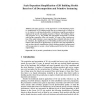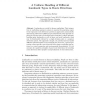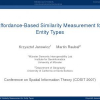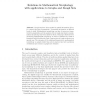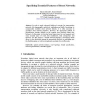105
click to vote
COSIT
2007
Springer
15 years 2 months ago
2007
Springer
Abstract. The paper proposes a novel approach for a scale-dependent geometric simplification of 3D building models that are an integral part of virtual cities. In contrast to real-...
124
click to vote
COSIT
2007
Springer
15 years 4 months ago
2007
Springer
Consistent and flawless communication between humans and machines is the precondition for a computer to process instructions correctly. While machines use well-defined languages an...
109
click to vote
COSIT
2007
Springer
15 years 4 months ago
2007
Springer
Abstract. Landmarks are crucial for human wayfinding. Their integration in wayfinding assistance systems is essential for generating cognitively ergonomic route directions. I prese...
133
click to vote
COSIT
2007
Springer
15 years 4 months ago
2007
Springer
Previous work is reviewed and an experiment described to examine the spatial and strategic cognitive factors impacting on human orientation in the `drop-off' static orientatio...
COSIT
2007
Springer
15 years 4 months ago
2007
Springer
Abstract. We present a methodology of how to use a top-level ontology to create a domain ontology from existing scientific texts by (1) identifying informal definitions of domain-s...
COSIT
2007
Springer
15 years 6 months ago
2007
Springer
120
click to vote
COSIT
2007
Springer
15 years 6 months ago
2007
Springer
Higher level semantics are considered useful in the geospatial domain, yet there is no general consensus on the form these semantics should take. Indeed, knowledge representation p...
107
click to vote
COSIT
2007
Springer
15 years 6 months ago
2007
Springer
Rough sets have been applied in spatial information theory to construct theories of granularity – presenting information at different levels of detail. Mathematical morphology c...
111
click to vote
COSIT
2007
Springer
15 years 6 months ago
2007
Springer
When animals (including humans) first explore a new environment, what they remember is fragmentary knowledge about the places visited. Yet, they have to use such fragmentary knowl...
COSIT
2007
Springer
15 years 6 months ago
2007
Springer
In order to apply advanced high-level concepts for transportation networks, like hypergraphs, multi-level wayfinding and traffic forecasting, to commercially available street netwo...
